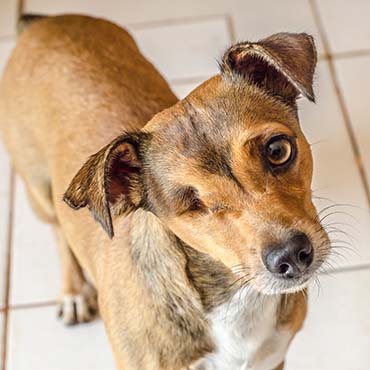Enucleation - eye removal in dogs
Overview
- Removing an eye (enucleation) is usually a last resort, but is necessary in some circumstances.
- Your vet may advise removing an eye if it’s been badly damaged, is causing unmanageable pain, is affected by an untreatable condition, or contains a tumour.
- This article contains information about eye removal surgery, recovery, and information on owning a partially sighted/blind dog.
When is eye removal necessary?
It might be a shock to hear that your dog needs an eye removing, but it’s the kindest option if it’s been badly damaged, contains a tumour or has an untreatable/very painful condition. Severe eye ulcers, severe eye injuries, tumours, uveitis and glaucoma are all conditions that can lead to enucleation.

A dog after removal of its right eye.
Eye removal surgery - what to expect
If your dog needs an eye removed, they will have it done under general anaesthetic and will be given strong pain relief and local anaesthetic. They will have the fur around their eye clipped, their eyeball and eyelids carefully removed and their wound stitched up. Once the surgery is complete, skin will cover the empty eye socket and once the fur grows back, you will hardly see the scar.
Recovery and aftercare
Bruising. Your dog may come home with some bruising and swelling, which is likely to get worse in the first 24 hours.
Weeping. It’s normal to see a small amount of blood-stained fluid weeping from your dog’s wound but you should contact your vet if there is more than a few drips.
Pain. After their surgery, your dog is likely to be in a small amount of discomfort, but most of their pain will be controlled with medication. Once your dog has returned home, you will need to continue their medicines at the correct times and contact your vet if they seem painful.
Protect the wound. You will need to prevent your dog damaging their wound, especially during the first 3-5 days after surgery. Your dog will come home with a head cone (Elizabethan collar), which they must wear at all times, until your vet advises removal. You will need to stop other pets licking your dog’s wound by keeping them separate if necessary.
Medication. Your vet will send your dog home with medication; you may find our medication planner useful.
Rest and TLC. Your dog will need a comfortable, warm, quiet place to rest during their recovery.
Food. Soft food may help if your dog seems painful when they eat.
Owning a one-eyed dog/blind dog
One-eyed dogs. Owning a one-eyed dog isn’t particularly different to owning a fully sighted dog, they tend to adapt very well. Below are some tips to help them:
- Talk to them when you approach them on their blind side to avoid startling them. Mention this to visitors and take extra care with other animals and small children.
- Move any head height objects that could damage your dog.
- Take care when walking in busy areas and around cars - your dog may not notice things on their blind side.
Blind dog. Caring for a blind pet is a big responsibility, but is possible if they adapt. Read our full article on caring for a blind dog.
Cost
An enucleation operation can be very expensive, especially if there are any complications. It’s important to speak to your vet openly about your finances, the cost of treatment, as well as what you think is right for your dog.
When you welcome a new dog into your life, consider getting dog insurance straight away before any signs of illness start. This will give you peace of mind that you have some financial support if they ever get sick.
Published: January 2020
Did you find this page useful?
Tell us more
Please note, our vets and nurses are unable to respond to questions via this form. If you are concerned about your pet’s health, please contact your vet directly.
Thank you for your feedback
Want to hear more about PDSA and get pet care tips from our vet experts?
Sign up to our e-newsletter
Written by vets and vet nurses. This advice is for UK pets only. Illustrations by Samantha Elmhurst.

